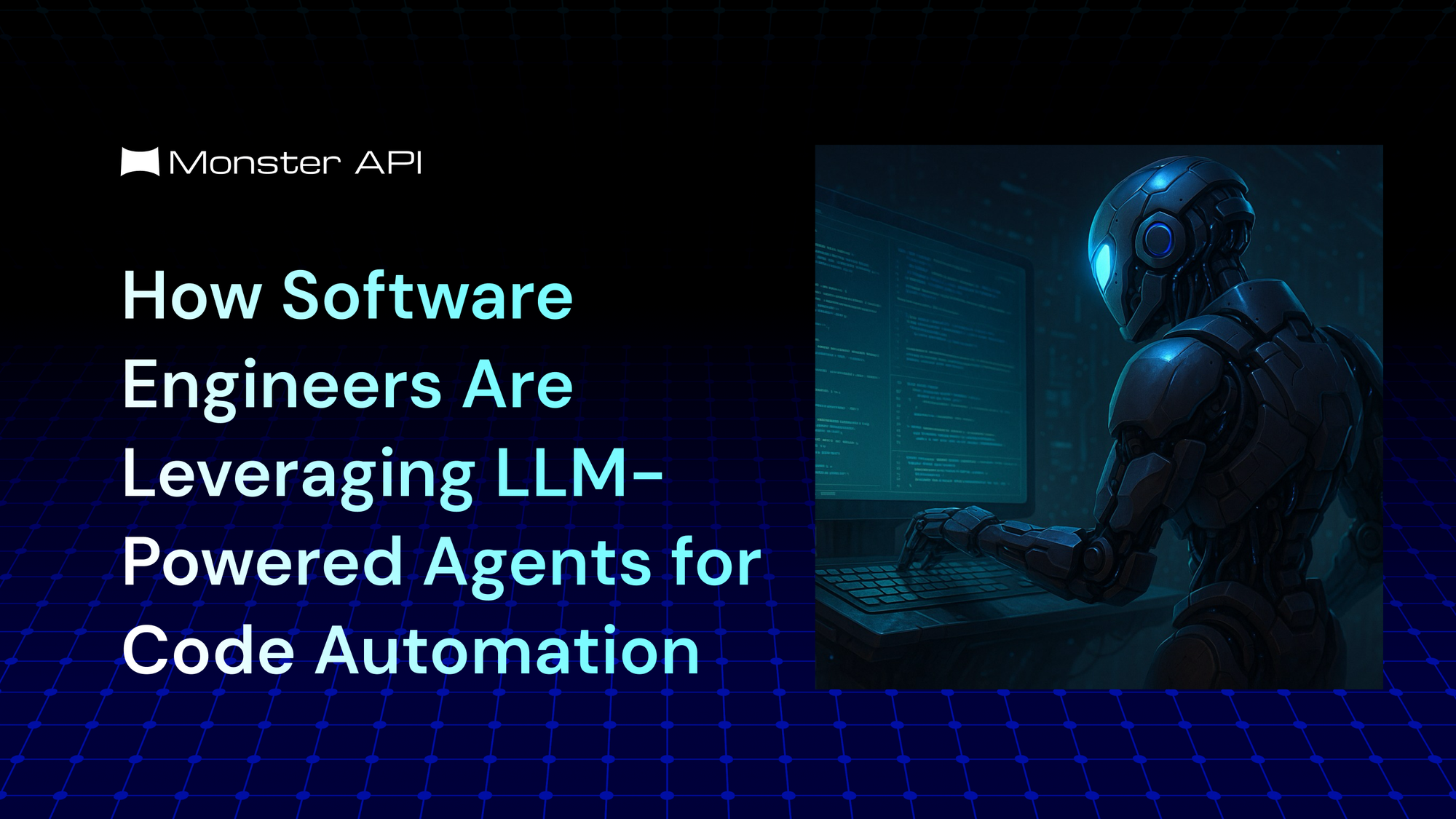How Software Engineers Are Leveraging LLM-Powered Agents For Code Automation
Autonomous software engineering agents are reshaping development by handling tasks like planning, coding, testing, and debugging with minimal supervision. In this blog we will explore the components that enable this autonomy.

Introduction
The growing capabilities of large language models (LLMs) have opened up a new possibility in software development: autonomous agents that can reason about tasks, write code, and interact with development tools—all with limited human input. While early LLM-based assistants focused on autocomplete and code suggestions, recent systems aim higher—enabling agents to interpret goals, generate and test solutions, and iteratively refine their output. These systems represent a shift in how we think about automation in software engineering. In this blog we will explore the components that enable this autonomy—examining how these agents use large language models (LLMs), and how MonsterAPI provides the infrastructure to support them.
What Are Autonomous Software Engineers?
Autonomous software engineers are AI agents designed to handle end-to-end development tasks without constant human supervision. Unlike traditional developer tools or AI copilots which act as assistants these agents behave more like independent contributors, capable of understanding goals, breaking them down into subtasks, writing functional code, testing it, and deploying it all on their own.
At the heart of these agents is a combination of language models, planning modules, tool interfaces, memory systems, and feedback mechanisms. Together, these components allow the agent to operate like a human developer in a digital workspace.
Key Components Enabling LLM-Powered Autonomy
The functionality of autonomous software engineering agents is not driven by the LLM alone. These systems rely on a set of coordinated components that allow the model to reason across multiple steps, track execution context, interact with development tools, and refine outputs. Below is a breakdown of the essential components found across agents.
1. LLM as the Reasoning Engine
At the core of every autonomous agent is a language model that performs multiple types of reasoning:
- Instruction understanding: Converts high-level goals (e.g., bug reports or feature requests) into actionable development tasks.
- Context-aware code generation: Writes or modifies code with awareness of file structure, function dependencies, and project-specific patterns.
- Failure analysis: Interprets error messages, logs, or failed tests to decide what needs fixing and where.
- Planning and task routing: In more advanced systems, the LLM also proposes or adjusts execution plans based on feedback from previous steps.
The model engages in a multi-turn reasoning loop, where each output becomes the input for the next step.
2. Planning Module
The planning component is responsible for translating a high-level task into a series of executable steps. This may be:
- LLM-driven, where the plan is generated as a list of actions using chain-of-thought or tree-of-thought prompting
- Rule-based, where task decomposition is defined by hand-coded logic
- Hybrid, where LLMs generate plans which are validated or modified by external rules
The planner ensures that the agent does not operate reactively but follows a structured progression toward the goal.
3. Tool Interface Layer
Autonomous agents operate within a sandboxed environment that includes access to:
- Shell/Terminal – for running commands, installing dependencies, or executing scripts
- Code Editor API – to read, write, and modify files
- Version Control (e.g., Git) – for managing commits and pull requests
- Test Runners / Debuggers – for validating code and capturing logs
LLMs generate inputs to these tools, often as command strings, which the system then executes. Outputs are parsed and passed back to the model to guide next steps.
4. Memory and State Tracking
To maintain context across long-running tasks, agents implement short- and long-term memory:
- Short-term memory retains the current plan, recent tool outputs, and active file contents
- Long-term memory may include scratchpads, project metadata, or historical command logs
Memory ensures the LLM doesn’t lose track of earlier steps and can refer back to past actions when generating new outputs. It also prevents redundant work by remembering already completed sub-tasks.
5. Feedback Loop and Iterative Refinement
Most agents operate in a loop that cycles through:
- Execution → Observation → Interpretation → Correction
When a script fails or a test doesn’t pass, the system doesn’t halt. Instead:
- The LLM re-interprets the failure logs or output
- Proposes modifications to the original code or command
- Re-attempts the task based on the new hypothesis
This loop continues until success conditions are met (e.g., all tests pass, no runtime errors) or a retry limit is reached. The feedback loop is central to the system’s autonomy.
Prominent Autonomous Software Engineer Agents: Capabilities and LLM Integration
The field of autonomous software engineering agents has seen rapid advancements, with several notable projects demonstrating how large language models (LLMs) can be leveraged to automate complex development workflows. Below is an overview of some of the most prominent agents, grouped by their operational scope and maturity.
Devin (by Cognition): Devin is a production-grade autonomous AI software engineer capable of handling complex development workflows. It integrates deeply with cloud infrastructure and developer tools to automate tasks such as writing code, debugging, running tests, and submitting pull requests.
- LLM Integration Highlights:
- Instruction Parsing: Uses LLMs to convert high-level requirements (e.g., GitHub issues) into actionable subtasks.
- Code Planning: Generates stepwise development plans via structured prompting.
- Code Generation: Writes modular, context-aware code across multi-file projects, respecting APIs and conventions.
- Error Interpretation & Self-Correction: Analyses test failures and logs to hypothesize fixes and revise code.
- Terminal Command Execution: Decides and runs shell commands for environment setup, builds, and tests.
- Stateful Reasoning: Maintains task context and intermediate results using persistent memory.
SWE-Agent (by Princeton and Meta): SWE-Agent focuses on test-driven development by synthesizing and repairing code iteratively based on issue descriptions and test outcomes. It is a research-driven system designed for modularity and extensibility.
- LLM Integration Highlights:
- Converts issue descriptions into hypotheses on required code changes.
- Synthesizes candidate solutions aligned with problem constraints.
- Uses test feedback to iteratively refine code through structured prompts.
- Maps errors (stack traces, assertion failures) to specific code modifications.
AutoCodeRover: AutoCodeRover specializes in autonomous bug detection and patch generation within real-world codebases. It reads multi-file repositories, identifies buggy logic, and generates targeted fixes validated by test suites.
- LLM Integration Highlights:
- Deep codebase comprehension for locating fault points.
- Patch generation driven by test failure analysis.
- Generates commit messages explaining changes for auditability.
How MonsterAPI Makes This Easier
To make LLM-powered agents practically useful in software engineering workflows, developers need more than just a language model; they require scalable infrastructure for inference, fine-tuning, deployment, and task orchestration. Agents like Devin or SWE-Agent rely on a consistent backend to run models efficiently, route tool interactions, and manage long-running tasks. This is where platforms like MonsterAPI become essential.
MonsterAPI provides a set of services that align closely with the needs of teams building or integrating autonomous agents into their workflows:
- No-Code Fine-Tuning: MonsterAPI offers a user-friendly interface to fine-tune over 80 open-source models, including LLaMA, Mistral, and Gemma. This process requires no coding, reducing the setup time and infrastructure overhead typically required.
- One-Click Deployment: Once a model is trained or fine-tuned, it can be deployed as a production-ready REST API using Monster Deploy. This abstracts the complexity of GPU provisioning, scaling, and environment setup, allowing developers to focus on agent logic rather than infrastructure.
- Function Calling Support: To interact with external tools—editors, shells, test runners—agents require structured operations. MonsterAPI supports models with function calling, enabling developers to link LLM outputs to executable functions safely and predictably.
- Scalable Runtime Configuration: Users can define memory, compute, and concurrency constraints for model execution. This is especially useful for agents that operate over long sessions or require high-throughput task execution.
- Iterative Prototyping: For research teams or startups building new agent frameworks, MonsterAPI offers a fast experimentation cycle. Developers can swap models, test prompts, and deploy chains with minimal configuration, making it easier to evolve complex agent architectures.
Conclusion:
Autonomous software engineering agents are redefining how development tasks are executed. By combining LLMs with planning, memory, tool integration, and feedback systems, these agents move beyond assistance into automation—capable of interpreting goals, generating code, and adapting based on results.Autonomous software engineers like Devin demonstrate what becomes possible when these components work together. With platforms like MonsterAPI enabling fine-tuning, tool execution, and deployment, building and scaling such systems is becoming increasingly accessible.
As this space evolves, developers may spend less time writing every line and more time designing workflows that intelligent agents can carry out—redefining the developer’s role in the process.

